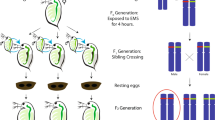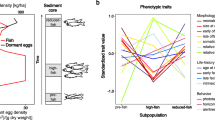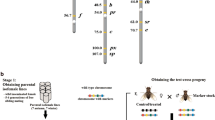Abstract
DDT* residues have already been implicated in widespread disruption of various ecosystems1–10. We report here the possibility of their being indirectly responsible for alterations in the genetic content of populations. Our conclusions are based on correlations between chromosomal changes in the fly Drosophila pseudoobscura described over the past 24 years in the western US by Dobzhansky and various collaborators and the distribution patterns of DDT residues we are finding throughout this area. In addition to general geographic correlation, there are several episodes in which these particular genetic effects occurred immediately after DDT application in the particular areas involved.
This is a preview of subscription content, access via your institution
Access options
Subscribe to this journal
Receive 51 print issues and online access
$199.00 per year
only $3.90 per issue
Buy this article
- Purchase on Springer Link
- Instant access to full article PDF
Prices may be subject to local taxes which are calculated during checkout
Similar content being viewed by others
References
Wurster, C. F., Science, 159, 1474 (1968).
Sodergren, A., Oikos, 19, 126 (1968).
Menzel, D. W., Anderson, J., and Randkte, A., Science, 167, 1724 (1970).
Porter, R. D., and Wiemeyer, S. N., Science, 165, 199 (1969).
Wurster, C. F., and Wingate, D. B., Science, 159, 979 (1968).
Hickey, J. J., and Anderson, D. W., Science, 162, 271 (1968).
Ratcliffe, D. A., Nature, 215, 208 (1967).
Tatton, J. O'G., and Ruzicka, J., Nature, 215, 346 (1967).
Risebrough, R. W., Menzel, D. B., Martin, D. J., and Olcutt, H. S., Nature, 216, 589 (1967).
Cory, L., Fjeld, P., and Serat, W., Pesticides Monit. J., 3, 204 (1970).
Dobzhansky, Th., and Sturtevant, A. H., Genetics, 23, 28 (1938).
Wright, S., and Dobzhansky, Th., Genetics, 31, 125 (1945).
Levine, R. P., Evolution, 6, 216 (1952).
Levene, H., Pavlovsky, O., and Dobzhansky, Th., Evolution, 8, 335 (1954).
Dobzhansky, Th., and Spassky, N., Proc. US Nat. Acad. Sci., 40, 407 (1954).
Dobzhansky, Th., and Spassky, B., Proc. US Nat. Acad. Sci., 48, 1704 (1962).
Dobzhansky, Th., Heredity, 1, 53 (1947).
Dobzhansky, Th., Evolution, 6, 234 (1952).
Strickberger, M. W., and Wills, C. J., Evolution, 20, 592 (1966).
Dobzhansky, Th., Evolution, 10, 82 (1956).
Dobzhansky, Th., Evolution, 12, 385 (1958).
Dobzhansky, Th., Anderson, W. W., Pavlovsky, O., Spassky, B., and Wills, C. J., Evolution, 18, 164 (1964).
Dobzhansky, Th., Anderson, W. W., and Pavlovsky, O., Evolution, 20, 418 (1966).
Dobzhansky, Th., Evolution, 17, 333 (1963).
Risebrough, R. W., Huggett, R. J., and Griffin, J. J., Science, 159, 1233 (1969).
Cohen, J. M., and Pinkerton, C., Advan. Chem. No. 60, 163 (Amer. Chem. Soc. Washington, 1966).
Cory, L., Amer. Zool., 2, 401 (1962).
O'Briend, R. D., Insecticides, Action and Metabolism, 125 (Academic Press, New York and London, 1967).
Report: The Control of the Lodgepole Needle Miner by the Use of Aerial Application of DDT Spray, Yosemite National Park, Season of 1953 (US Department of Agriculture, Forest Service, California Forest and Range Experiment Station, 1956).
Report: Control of an Infestation of the Douglas-fir Tussock Moth with DDT Aerial Spray, Calaveras and Tuolumne Counties, California, 1956 (US Department of Agriculture, Forest Service, California Forest and Range Experiment Station, 1957).
Dimond, J., and Sherburne, J. A., Nature, 221, 468 (1969).
Report: Aerial Spraying and Dusting Projects in Oregon and Washington, 1931–1965 (US Department of Agriculture, Pacific Northwest Region, 1966).
Anderson, W. W., Oshima, C., Watanabe, T., Dobzhansky, Th., and Pavlovsky, O., Genetics, 58, 423 (1968).
Author information
Authors and Affiliations
Rights and permissions
About this article
Cite this article
CORY, L., FJELD, P. & SERAT, W. Environmental DDT and the Genetics of Natural Populations. Nature 229, 128–130 (1971). https://doi.org/10.1038/229128a0
Received:
Revised:
Issue Date:
DOI: https://doi.org/10.1038/229128a0
This article is cited by
-
DDT in California Sea Lions
Nature (1971)
Comments
By submitting a comment you agree to abide by our Terms and Community Guidelines. If you find something abusive or that does not comply with our terms or guidelines please flag it as inappropriate.



